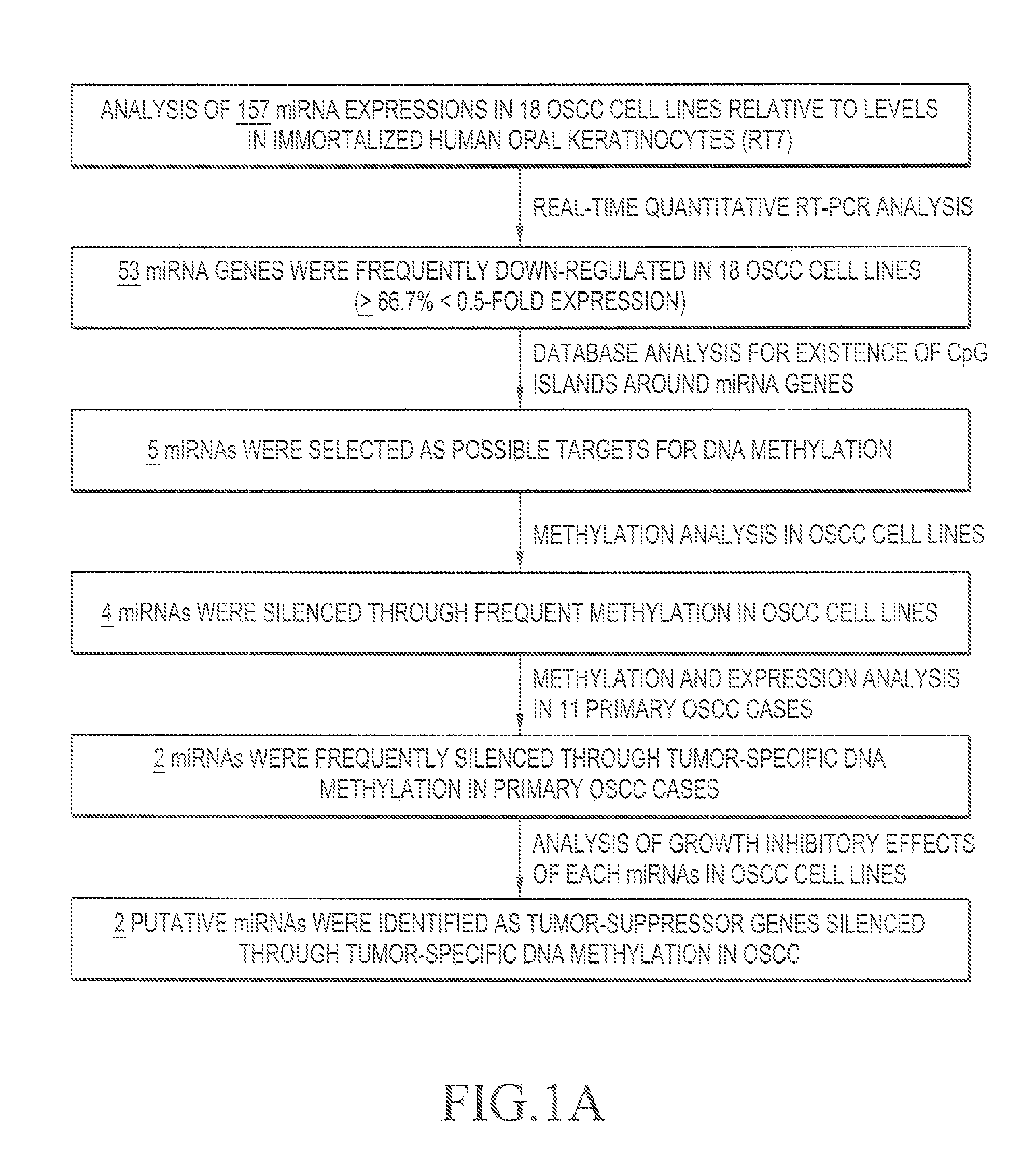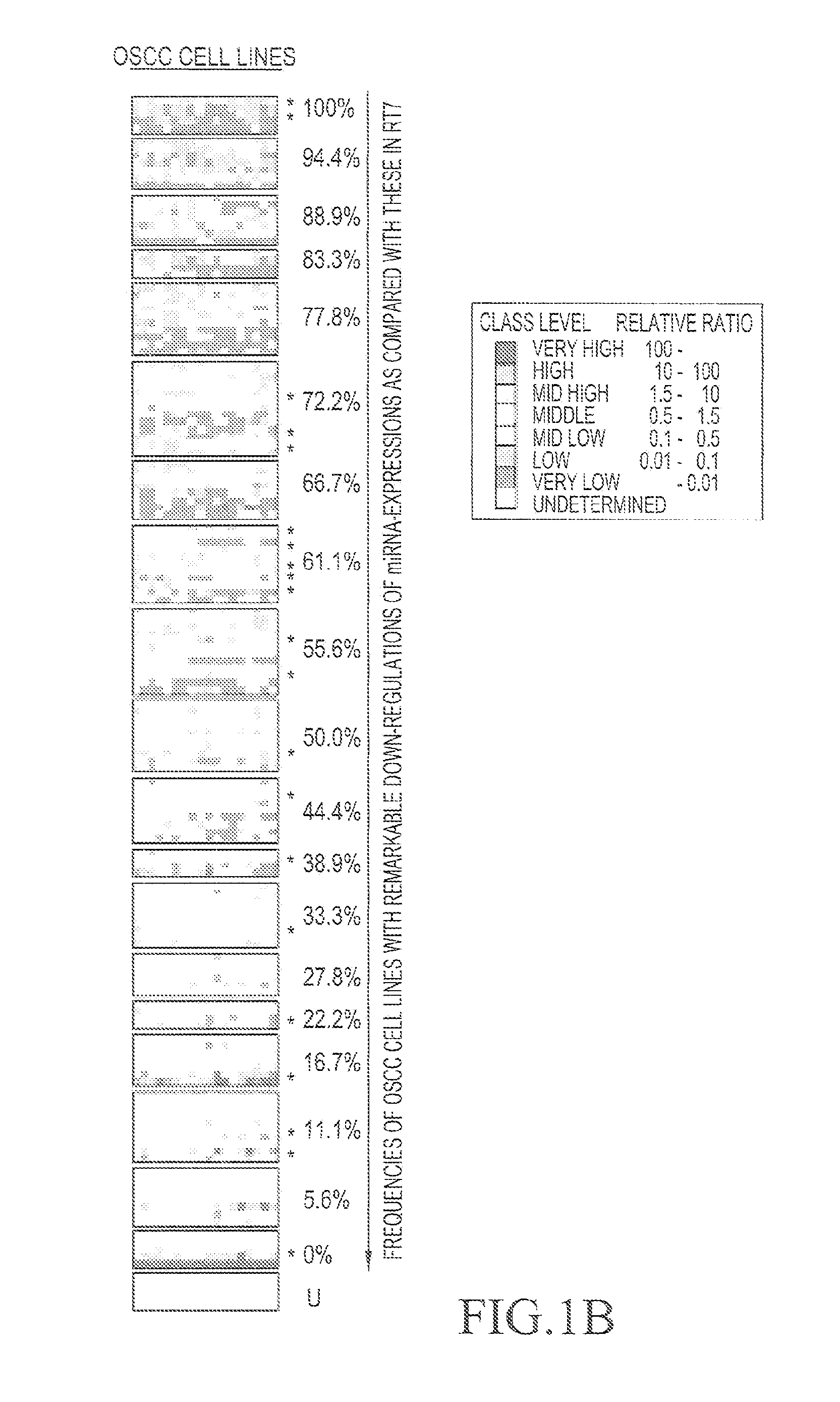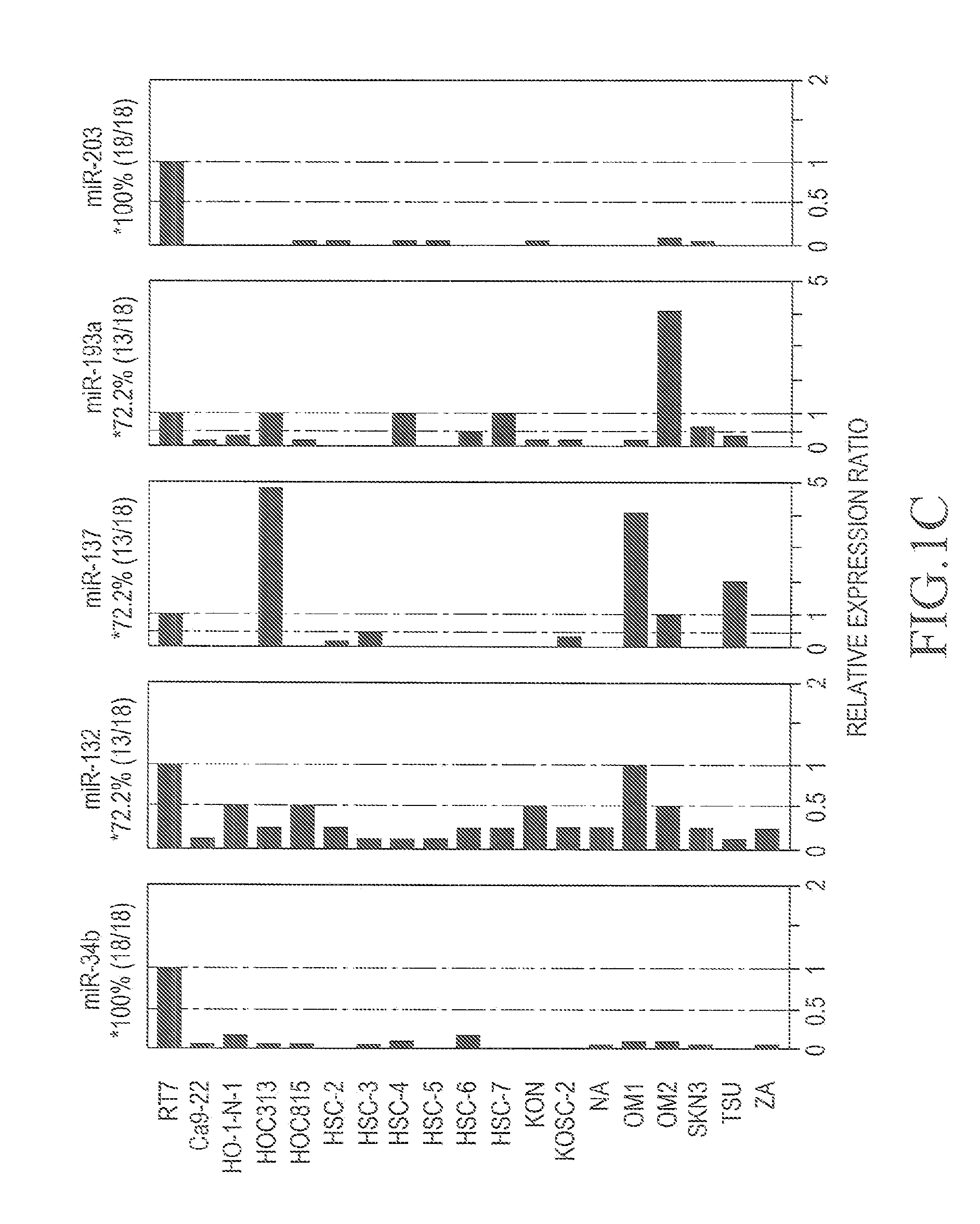Method for detecting carcinoma and agent for suppressing carcinoma
a technology for detecting carcinoma and suppressing carcinoma, applied in the field of detecting carcinoma, can solve problems such as the acceleration of oral squamous cell carcinoma growth, and achieve the effect of suppressing the growth of carcinoma and accurate understanding of malignant transformation
- Summary
- Abstract
- Description
- Claims
- Application Information
AI Technical Summary
Benefits of technology
Problems solved by technology
Method used
Image
Examples
example 1
Changes in miRNA Gene Expression in Oral Squamous-Cell Carcinoma
[0044]To detect changes in miRNA gene expression in oral squamous-cell carcinoma, 18 types of oral squamous-cell carcinoma cell lines (Ca9-22, HO-1-N-1, HSC-2, HSC-3, HSC-4, KOSC-2 c13-43, HOC-313, HOC-815, HSC-5, HSC-6, HSC-7, KON, NA, OM1, 0M2, SKN3, TSU, and ZA) were used. As a control, a normal oral mucosal epithelium-derived immortalized cell line, RT7, was used. The oral squamous-cell carcinoma cell line was cultured in DMEM medium containing streptomycin (100 μg / ml), penicillin (100 units / ml), 2 mM glutamine, and 10% fetal bovine serum (FBS). The RT7 cell line was cultured using the KGM-2 Bullet Kit (Cambrex). Genomic DNA was extracted therefrom using the Genome DNA Purification kit (Gentra, Minneapolis, Minn.), and RNA was extracted using Isogen (Nippon Gene), in accordance with manufacturers' instructions.
[0045]FIG. 1A shows the strategy for isolating antioncogenic miRNA, the gene expression level of which has ...
example 2
Analysis of Candidate miRNA and Methylation in Oral Squamous-Cell Carcinoma Cell Lines
[0049]The human genome database (http: / / genome.ucsc.edu / ) was screened for the presence of CpG islands in the vicinities of 157 types of miRNA genes. As a result, 21 types of miRNA genes were found to be located on or around (within 1,000-bp) the CpG islands (Table 3).
TABLE 321 miRNAs located on / around CpG islandsmiRNALocusmiR-9miR-9-1, 1q22; miR-9-3, 15q26.1miR-9*miR-9-1, 1q22; miR-9-3, 15q26.1miR-34b11q23.1miR-92miR-92-1, 13q31.3; miR-92-2, Xq26.2; miR-92b, 1q22miR-124amiR-124a-1, 8p23.1; mir-124a-2, 8q12.3; miR-124a-3, 20q13.33miR-126 9q34.3miR-12714q32.31miR-129miR-129-1, 7q32.1; miR-129-2, 11p11.2miR-13217p13.3miR-137 1p21.3miR-149 2q37.3miR-15217q21.32miR-189 9q22.32 (Replaced by miR-21-1)miR-191 3p21.31miR-193a17q11.2miR-20314q32.33miR-21011p.15.5miR-219miR-219-1, 6p21.32; miR-219-2, 9q34.11miR-320 8p21.3miR-339 7p22.3let-7i12q14.1
[0050]Among the 21 types of miRNA genes, the miR-34b, miR-132...
example 3
Analysis of miRNA Expression and Methylation in Specimen from Patient with Oral Squamous-Cell Carcinoma
[0057]Whether or not methylation of four types of miRNA genes has occurred in cancerous tissue of a patient with oral squamous-cell carcinoma and the correlation between the state of DNA methylation of the four types of miRNA genes and the expression patterns in cancerous tissue of a patient with oral squamous-cell carcinoma were analyzed by using the COBRA method and TaqMan real-time RT-PCR analysis.
[0058]Regarding cancerous and noncancerous tissue samples of patients with oral squamous-cell carcinoma, 11 cases of frozen samples (T1: 0 cases; T2: 10 cases; T3: 0 cases; T4: 1 case) were obtained with the approval of the Ethics Committee of Tokyo Dental and Medical University, followed by acquisition of written agreements from patients with oral squamous-cell carcinoma who had undergone surgery at the Tokyo Dental and Medical University Hospital, Faculty of Dentistry. The relevant s...
PUM
| Property | Measurement | Unit |
|---|---|---|
| Northern blotting | aaaaa | aaaaa |
| physical | aaaaa | aaaaa |
| size | aaaaa | aaaaa |
Abstract
Description
Claims
Application Information
 Login to View More
Login to View More - R&D
- Intellectual Property
- Life Sciences
- Materials
- Tech Scout
- Unparalleled Data Quality
- Higher Quality Content
- 60% Fewer Hallucinations
Browse by: Latest US Patents, China's latest patents, Technical Efficacy Thesaurus, Application Domain, Technology Topic, Popular Technical Reports.
© 2025 PatSnap. All rights reserved.Legal|Privacy policy|Modern Slavery Act Transparency Statement|Sitemap|About US| Contact US: help@patsnap.com



